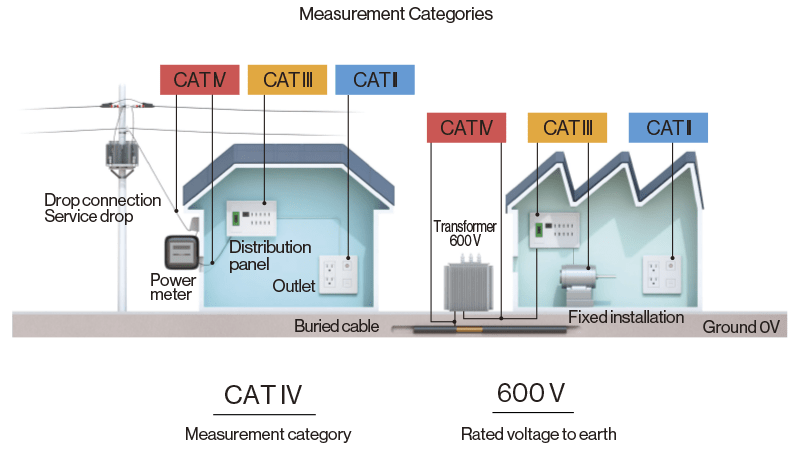Ensuring Safe Operation
Ensuring the safe operation of your product
To ensure safe use of measuring instruments, the following information is provided under “Specifications” in the user manual.
Ratings
Maximum rated voltage to earth
Voltage of the measurement location relative to ground
Rated voltage between terminals, rated input voltage
This value refers to the voltage between the measurement terminals of the instrument.
Anticipated transient overvoltage
This indicates the maximum expected overvoltage at the measurement point.
Transient overvoltages (impulse-like voltages) up to approximately 10 times the rated voltage may occur at the measurement point. Instruments are designed to safely withstand the expected overvoltage at the measurement point without compromising safety.
Safety standards define (IEC/EN 61010 series) the following transient overvoltage values based on the rated voltage to earth and measurement categories.
| Voltage at the measurement point [V] | Anticipated transient overvoltage value [V] | ||
|---|---|---|---|
| Measurement category II (CAT II) | Measurement category III (CAT III) | Measurement category IV (CAT IV) | |
| 300 | 2,500 | 4,000 | 6,000 |
| 600 | 4,000 | 6,000 | 8,000 |
| 1,000 | 6,000 | 8,000 | 12,000 |
| 1,500 | 8,000 | 10,000 | 15,000 |
| 2,000 | 12,000 | 15,000 | 18,000 |
About measurement categories
These categories indicate which parts of the power system can be measured using a measuring instrument. According to safety standards (IEC/EN 61010 series), measurement locations are classified as CAT II through CAT IV based on factors such as line-to-ground voltage, current capacity (short-circuit current), and expected transient overvoltages.
| Measurement category II (CAT II) | From the power outlet plug to the power circuit of electrical equipment via the power cord |
|---|---|
| Measurement category III (CAT III) | From the distribution board (main switch) through indoor wiring to the terminal behind the outlet |
| Measurement category IV (CAT IV) | From the service line entering a building to the distribution board (main switch) |
When measuring power systems, use instruments rated for the measurement category (CAT II, III, or IV) or higher and ensure that the instrument’s rated line-to-ground voltage and terminal-to-terminal voltage are not exceeded.
Location of use
Pollution Degree
This information indicates the environmental conditions under which the instrument can be used. Contamination on the surface of the instrument may reduce insulation performance and increase the risk of electric shock. According to safety standards (IEC/EN 61010 series), pollution levels are classified as follows:
| Pollution Degree 1 | No pollution, or only dry non-conductive contamination |
|---|---|
| Pollution Degree 2 | Dry, non-conductive contamination that may become conductive due to condensation |
| Pollution Degree 3 | Conductive contamination, or dry contamination that becomes conductive when exposed to moisture or condensation |
| Pollution Degree 4 | Continuous conductive contamination caused by conductive substances, rain, or high humidity, significantly affecting insulation performance |
Elevation
This value specifies the maximum altitude (elevation) at which the instrument can be safely used. Atmospheric pressure decreases as elevation increases, increasing the likelihood of electrical discharges (caused by insulation breakdown of air). The instrument is designed to operate safely up to the elevation specified in the manual.
Indoor/outdoor use
This information indicates the environmental conditions under which the instrument can be used. Instruments for outdoor use are designed to resist water exposure more effectively given their frequent contact with moisture.

